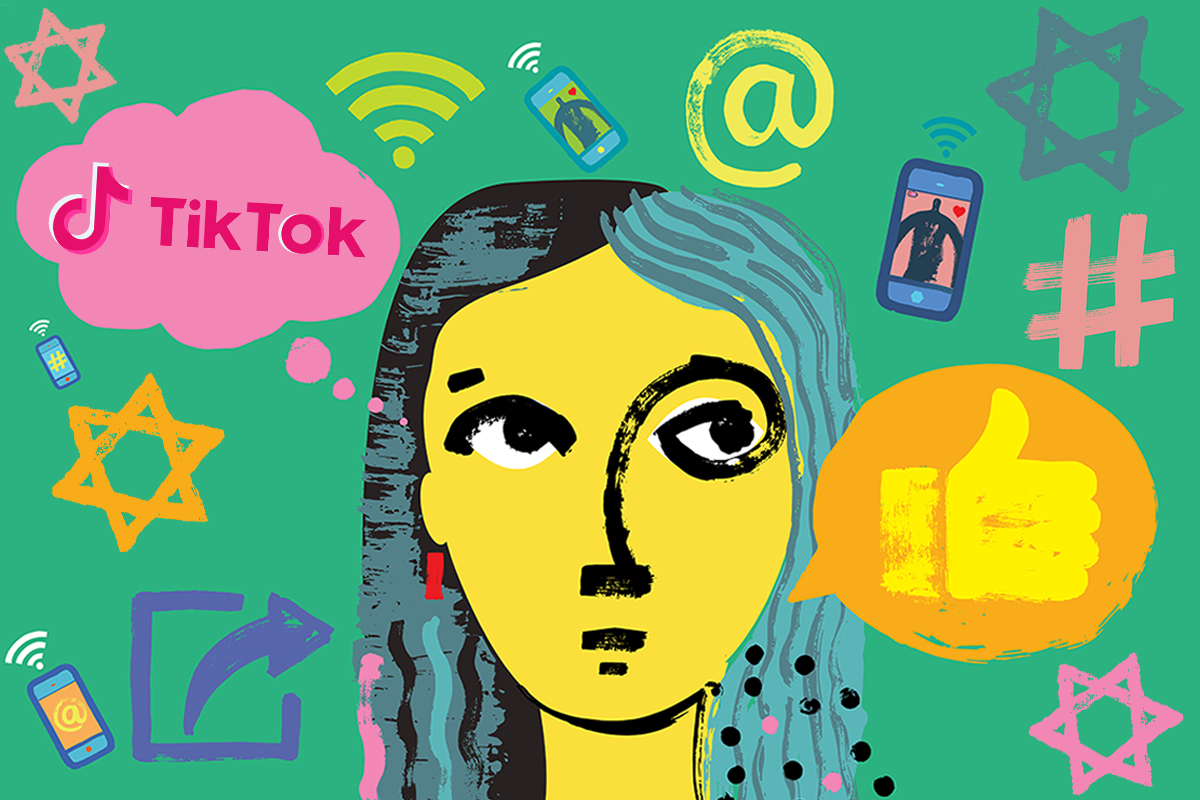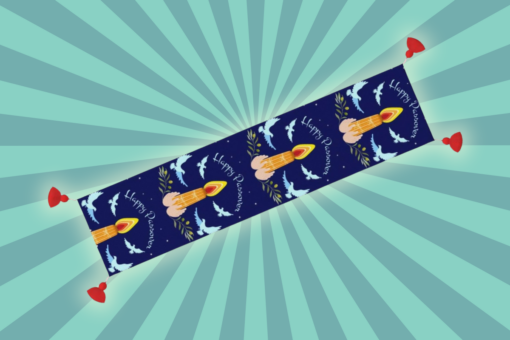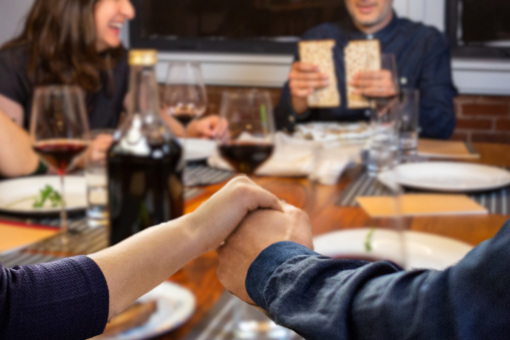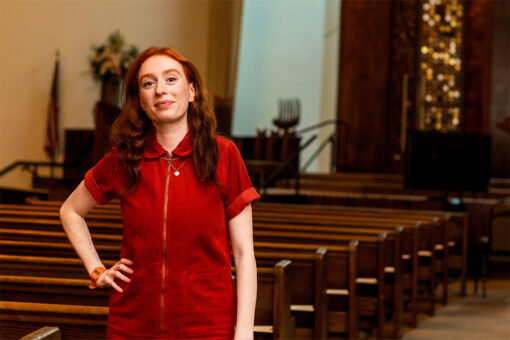For many students, the start of school this fall means a return to the dreaded Zoom classroom. Awkward virtual hand raises and long slideshow lectures became the norm this past spring, when the COVID-19 pandemic forced school campuses to shut down. Zoom fatigue and the boredom of quarantine prompted many young people to download TikTok, a platform that revives the creative chaos of Vine and the dance challenge content of musical.ly.
But TikTok’s “For You” page, the central feed of the app, spirals far beyond trendy choreography tutorials. The app, like other AI-driven platforms, starts to guess at our preferences: After a few days on TikTok, I was inevitably bombarded with Jewish summer camp content and Long Island memes.
I was pleasantly surprised, however, by the educational Jewish TikToks that started showing up on my feed. Through creators like @slaviccaesar, I learned about Jewish artists like Frieda Belinfante and unsung historical figures like Dr. Feng Shan Ho, the so-called “Chinese Schindler.” And this, I quickly discovered, was just the tipping point. For those hungry for Jewish history, culture, and (highly educational) memes, TikTok offers an exciting alternative to stodgy Hebrew school lessons and Zoom breakout room discussions. For the uninitiated, I offer a hearty welcome to TikTok’s Jewish School.
Leonora Tepper (@dybbuk.girl.03) downloaded TikTok in the spring as the monotony of remote school set in. “I just started having fun with it,” she told me over the phone. “I was like, ‘Hey, what if I make TikTok videos from the point of view of a shtetl girl?’”
The 17-year-old Fiddler on the Roof superfan has since amassed over 12,000 followers with a unique mix of shtetl-centered content, including Jewish folklore explainers and Labour Bund romance videos. In one popular TikTok, Tepper dresses up as a fictional shtetl meydeleh (shtetl woman), Raizel Nuchimovitz, whose biographical details she crowdsourced from a previous TikTok. In another video, she explains the lyrics of “Daloy Politsey” (“Down with the Police”), a Yiddish anarchist song she learned at summer camp.
For Tepper, Jewish history provides a path to engage with our current political moment, including the reality of police injustice. “It’s hard to know where to get involved, but I think if you’re Jewish, you can tap into your heritage that already exists, your heritage of radical left politics. I feel like, when you don’t know where to start, you can take inspiration from your ancestors.”
To research her videos, Tepper consults resources like the Encyclopedia of Jewish Myth, Magic and Mysticism, and the Yiddish Book Center. TikTok, she said, is an ideal platform for educators. “Each video is short, so you can break down a complicated topic into a bunch of different videos with a little bit of information at a time.”
Amelia Greenblum — @milli_not_so_vanilli — harnessed this format to share the story of her oma, a Holocaust survivor, over the course of nearly 30 TikToks. Greenblum, 32, downloaded the app last November after some TikToks caught her eye on Instagram. The following month, her oma became sick. “She was my best friend in the whole world, and I was so touched by her sentiment in the last days of her life,” she said. “She really felt like she had a wonderful, beautiful life.”
After her oma’s passing, Greenblum decided to share her story. She began going through her belongings and compiling more information about her life. Greenblum, a lifelong history buff, tells her oma’s story with vivid, engaging detail. Her first video in the series, which has over 100,000 likes, introduces her oma in the frightening milieu of Nazi Germany. Greenblum goes on to chronicle the amazing twists and turns of her family’s life, from her oma’s survival of the Holocaust in hiding to the struggle of forging a life in America, reckoning with PTSD and engaging with the Civil Rights Movement.
For Greenblum, sharing the intergenerational trauma and resilience of her family’s story on a public platform was a form of catharsis. “That’s a huge part of why I started doing it, and the more I did, the more I felt better. Just being able to honor her memory and legacy and have other people celebrate her life was so healing for me.”
Greenblum also enjoys learning from other TikTokers. “It’s real people sharing their experiences. People are posting footage from the protests — stuff that’s not shown on the news, stuff that you’re not learning in school. I think for a lot of people [on TikTok], they’re being exposed to things they never would be exposed to in their normal lives.”
For Cameron Bernstein — @c.o.bernstein — this aspect of TikTok is key. “The randomness of the algorithm means that more people can stumble across content,” said Bernstein, who joined the app in quarantine after her college roommates went home, leaving her alone in her apartment.
She started creating TikToks in Yiddish as a fun way to engage with her class material. Bernstein signed up for her first Yiddish course at the University of Chicago last fall. “Academics were kind of gross for a while, and then I was like, ‘Oh wait, I can have fun through learning,’” she said. “Yiddish sounded interesting, and I like language.” After studying with a small group of students and a passionate professor, she decided to pursue Yiddish the rest of the year. “I wanted to do it because I’m an Ashkenazi Jew, so I know some Hebrew. But even though that’s the language we pray in, our cultural language is Yiddish.”
In an early TikTok, Bernstein assumes the identity of Rukhl, a fictional Jewish Russian immigrant and native Yiddish speaker. In subsequent videos, she uses the language of the shtetl to introduce herself, showcase her house plants, and explain the Yiddish alphabet.
Bernstein has met other young Yiddishists on the app, including Saul Glist, AKA @yiddishcowboy. They recently watched an ‘80s Yiddish disco musical together on Zoom. Still, for Bernstein, creating Yiddish TikToks can be lonely and daunting: “There’s this absence of voices because of the Holocaust, so when German speakers lovingly comment, ‘Oh my gosh, this is so close to German,’ I get a little sad. If these historic things didn’t happen, I wouldn’t be the first person they encountered who spoke Yiddish, so there’s a lot of pressure.”
Despite the challenges of being a young Yiddishist, engaging with the language online has enabled Bernstein to meaningfully connect to her secular Ashkenazi identity. “Ashkenormativity is a problem when it’s assumed as a baseline for all Jewish interactions,” she said. “When I interact with Yiddish, I get to say, ‘This is a very particular Jewish identity that I am able to celebrate and explore, and it is one of many Jewish cultures.’”
Reina B. — @shualshemesh — aims to showcase the diversity of Jewish life on their account, sharing artwork and educational videos about Sephardic and Mizrahi history and culture. “When it comes to Jewish TikTok, I haven’t seen many other Sephardic creators,” they said. “As much as we’re all still mishpacha, we’re still a family, I would really love to see more Sephardic creators out there. Hopefully we can make a little community ourselves.”
Reina also sees TikTok as a space to explore and share their own Sephardi family history, including the forced conversion of their ancestors during the Spanish Inquisition. “I want people to know that we’ll always be here,” Reina said. “We technically weren’t supposed to exist, but here we are still with our languages, our dresses, our culture.” Reina tackles the heavy subject with an ironic sense of levity. “A lot of generational trauma comes in with colonization and assimilation, and many people, including myself, use humor as a way to kind of cope with everything.”
From history explainers to intricate art videos, TikTok’s Jewish School is a dizzying kind of paradise, a place for the curious late-night scroller to cry from laughter and learn something new. For young students and aspiring educators like Bernstein, this little corner of the app can feel like an ideal antidote to the isolating reality of remote learning. It also presents a model for sharing and understanding underrepresented narratives and identities, perhaps one that we can pull from in the post-pandemic classroom. “TikTok is cool because people get to embrace their particularities, and there’s a resonance with people wanting to connect with their heritage,” Bernstein said. “It makes me feel less alone to know that all of us are out here.”
Header image design by Emily Burack. Original image by Sloop Communications/iStock /Getty Images.



